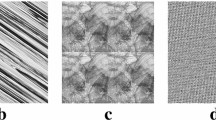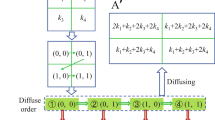Abstract
We propose a new asymmetric pixel confusion algorithm for images based on the Rivest-Shamir-Adleman (RSA) public-key cryptosystem and Arnold map. First, the RSA asymmetric algorithm is used to generate two groups of Arnold transform parameters to address the problem of symmetrical distribution of Arnold map parameters. Second, the image is divided into blocks, and the first group of parameters is used to perform Arnold confusion on each sub-block. Then, the second group of parameters is used to perform Arnold confusion on the entire image. The image correlation is thereby fully weakened, and the image confusion degree and effect are further enhanced. The experimental results show that the proposed image pixel confusion algorithm has better confusion effect than the classical Arnold map based confusion and the row-column exchange based confusion. Specifically, the values of gray difference are close to one. In addition, the security of the new confusion operation is dependent on RSA, and it can act as one part of a confusion-substitution structure in a cipher.
Similar content being viewed by others
Explore related subjects
Discover the latest articles and news from researchers in related subjects, suggested using machine learning.References
Abbas NA, 2016. Image encryption based on independent component analysis and Arnold’s cat map. Egypt Inform J, 17(1):139–146. https://doi.org/10.1016/j.eij.2015.10.001
Arab A, Rostami MJ, Ghavami B, 2019. An image encryption method based on chaos system and AES algorithm. J Supercomput, 75(10):6663–6682. https://doi.org/10.1007/s11227-019-02878-7
Boldyreva A, Imai H, Kobara K, 2010. How to strengthen the security of RSA-OAEP. IEEE Trans Inform Theory, 56(11):5876–5886. https://doi.org/10.1109/TIT.2010.2070330
Chen JX, Zhu ZL, Zhang LB, et al., 2018. Exploiting self-adaptive permutation-diffusion and DNA random encoding for secure and efficient image encryption. Signal Process, 142:340–353. https://doi.org/10.1016/j.sigpro.2017.07.034
Chen LF, Zhao DM, Ge F, 2013. Image encryption based on singular value decomposition and Arnold transform in fractional domain. Opt Commun, 291:98–103. https://doi.org/10.1016/j.optcom.2012.10.080
El-Khamy SE, Korany NO, El-Sherif MH, 2017. A security enhanced robust audio steganography algorithm for image hiding using sample comparison in discrete wavelet transform domain and RSA encryption. Multim Tool Appl, 76(22):24091–24106. https://doi.org/10.1007/s11042-016-4113-8
Gan ZH, Chai XL, Han DJ, et al., 2019. A chaotic image encryption algorithm based on 3-D bit-plane permutation. Neur Comput Appl, 31(11):7111–7130. https://doi.org/10.1007/s00521-018-3541-y
Gong LH, Qiu KD, Deng CZ, et al., 2019a. An image compression and encryption algorithm based on chaotic system and compressive sensing. Opt Laser Technol, 115:257–267. https://doi.org/10.1016/j.optlastec.2019.01.039
Gong LH, Qiu KD, Deng CZ, et al., 2019b. An optical image compression and encryption scheme based on compressive sensing and RSA algorithm. Opt Laser Eng, 121:169–180. https://doi.org/10.1016/j.optlaseng.2019.03.006
Hua ZY, Xu BX, Jin F, et al., 2019. Image encryption using Josephus problem and filtering diffusion. IEEE Access, 7:8660–8674. https://doi.org/10.1109/ACCESS.2018.2890116
Hui LCK, Lam KY, 1994. Fast square-and-multiply exponentiation for RSA. Electron Lett, 30(17):1396–1397.
Khashan OA, Zin AM, Sundararajan EA, 2015. ImgFS: a transparent cryptography for stored images using a filesystem in userspace. Front Inform Technol Electron Eng, 16(1):28–42. https://doi.org/10.1631/FITEE.1400133
Li P, Xu J, Mou J, et al., 2019. Fractional-order 4D hyperchaotic memristive system and application in color image encryption. EURASIP J Image Video Process, 2019:22. https://doi.org/10.1186/s13640-018-0402-7
Liu LF, Hao SD, Lin J, et al., 2018. Image block encryption algorithm based on chaotic maps. IET Signal Process, 12(1):22–30. https://doi.org/10.1049/iet-spr.2016.0584
Liu ZJ, Gong M, Dou YK, et al., 2012. Double image encryption by using Arnold transform and discrete fractional angular transform. Opt Laser Eng, 50(2):248–255. https://doi.org/10.1016/j.optlaseng.2011.08.006
Mansouri A, Wang XY, 2020. Image encryption using shuffled Arnold map and multiple values manipulations. Vis Comput.https://doi.org/10.1007/s00371-020-01791-y
Méndez-Ramírez R, Arellano-Delgado A, Cruz-Hernández C, et al., 2018. Chaotic digital cryptosystem using serial peripheral interface protocol and its dsPIC implementation. Front Inform Technol Electron Eng, 19(2):165–179. https://doi.org/10.1631/FITEE.1601346
Mitchell CJ, 2016. On the security of 2-key triple DES. IEEE Trans Inform Theory, 62(11):6260–6267. https://doi.org/10.1109/TIT.2016.2611003
Mossa E, 2017. Security enhancement for AES encrypted speech in communications. Int J Speech Technol, 20(1):163–169. https://doi.org/10.1007/s10772-017-9395-3
Patidar V, Pareek NK, Purohit G, et al., 2011. A robust and secure chaotic standard map based pseudorandom permutation-substitution scheme for image encryption. Opt Commun, 284(19):4331–4339. https://doi.org/10.1016/j.optcom.2011.05.028
Rawat N, Kim B, Kumar R, 2016. Fast digital image encryption based on compressive sensing using structurally random matrices and Arnold transform technique. Optik, 127(4):2282–2286. https://doi.org/10.1016/j.ijleo.2015.11.064
Sneha PS, Sankar S, Kumar AS, 2020. A chaotic colour image encryption scheme combining Walsh-Hadamard transform and Arnold-Tent maps. J Amb Intell Human Comput, 11(3):1289–1308. https://doi.org/10.1007/s12652-019-01385-0
Verma G, Liao MH, Lu DJ, et al., 2019. An optical asymmetric encryption scheme with biometric keys. Opt Laser Eng, 116:32–40. https://doi.org/10.1016/j.optlaseng.2018.12.010
Wu C, Hu LY, Wang Y, et al., 2019. Scalable asymmetric image encryption based on phase-truncation in cylindrical diffraction domain. Opt Commun, 448:26–32. https://doi.org/10.1016/j.optcom.2019.05.009
Xiao D, Wang Y, Xiang T, et al., 2017. High-payload completely reversible data hiding in encrypted images by an interpolation technique. Front Inform Technol Electron Eng, 18(11):1732–1743. https://doi.org/10.1631/FITEE.1601067
Yao LL, Yuan CJ, Qiang JJ, et al., 2017. An asymmetric color image encryption method by using deduced gyrator transform. Opt Laser Eng, 89:72–79. https://doi.org/10.1016/j.optlaseng.2016.06.006
Ye GD, 2010. Image scrambling encryption algorithm of pixel bit based on chaos map. Patt Recogn Lett, 31(5):347–354. https://doi.org/10.1016/j.patrec.2009.11.008
Ye GD, Huang XL, 2018. Spatial image encryption algorithm based on chaotic map and pixel frequency. Sci China Inform Sci, 61(5):058104. https://doi.org/10.1007/s11432-017-9191-x
Ye GD, Pan C, Huang XL, et al., 2018. An efficient pixellevel chaotic image encryption algorithm. Nonl Dynam, 94(1):745–756. https://doi.org/10.1007/s11071-018-4391-y
Yu SS, Zhou NR, Gong LH, et al., 2020. Optical image encryption algorithm based on phase-truncated short-time fractional Fourier transform and hyper-chaotic system. Opt Laser Eng, 124:105816. https://doi.org/10.1016/j.optlaseng.2019.105816
Zhou NR, Zhang AD, Zheng F, et al., 2014. Novel image compression-encryption hybrid algorithm based on key-controlled measurement matrix in compressive sensing. Opt Laser Technol, 62:152–160. https://doi.org/10.1016/j.optlastec.2014.02.015
Zhou NR, Hua TX, Gong LH, et al., 2015. Quantum image encryption based on generalized Arnold transform and double random-phase encoding. Quant Inform Process, 14(4):1193–1213. https://doi.org/10.1007/s11128-015-0926-z
Zhu HH, Chen XB, Yang YX, 2019. A quantum image dual-scrambling encryption scheme based on random permutation. Sci China Inform Sci, 62(12):229501. https://doi.org/10.1007/s11432-018-1514-y
Zhu ZL, Zhang W, Wong KW, et al., 2011. A chaos-based symmetric image encryption scheme using a bit-level permutation. Inform Sci, 181(6):1171–1186. https://doi.org/10.1016/j.ins.2010.11.009
Author information
Authors and Affiliations
Contributions
Xiao-ling HUANG and Guo-dong YE designed the research and provide suggestions. Kai-xin JIAO processed the data and drafted the manuscript. You-xia DONG helped organize the manuscript. Kai-xin JIAO and Guo-dong YE revised and finalized the paper.
Corresponding author
Additional information
Compliance with ethics guidelines
Xiao-ling HUANG, You-xia DONG, Kai-xin JIAO, and Guo-dong YE declare that they have no conflict of interest.
Project supported by the National Natural Science Foundation of China (Nos. 61972103 and 61702116), the Natural Science Foundation of Guangdong Province, China (No. 2019A1515011361), the Project of Enhancing School with Innovation of Guangdong Ocean University (No. Q18306), and the Guangdong Postgraduate Education Innovation Project (No. 2020JGXM059)
Rights and permissions
About this article
Cite this article
Huang, Xl., Dong, Yx., Jiao, Kx. et al. Asymmetric pixel confusion algorithm for images based on RSA and Arnold transform. Front Inform Technol Electron Eng 21, 1783–1794 (2020). https://doi.org/10.1631/FITEE.2000241
Received:
Accepted:
Published:
Issue Date:
DOI: https://doi.org/10.1631/FITEE.2000241




